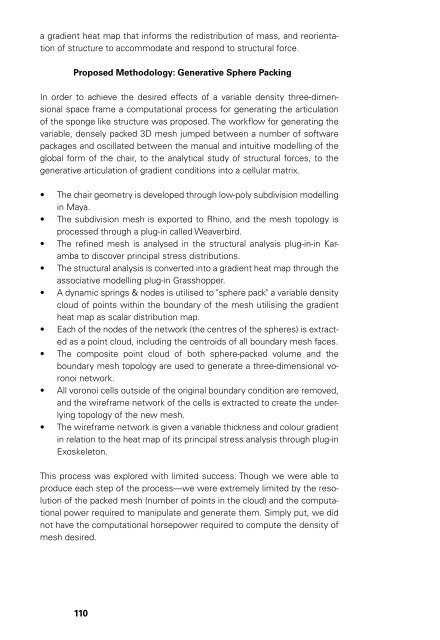Mixed Matters
ISBN 978-3-86859-421-8
ISBN 978-3-86859-421-8
Create successful ePaper yourself
Turn your PDF publications into a flip-book with our unique Google optimized e-Paper software.
a gradient heat map that informs the redistribution of mass, and reorientation<br />
of structure to accommodate and respond to structural force.<br />
Proposed Methodology: Generative Sphere Packing<br />
In order to achieve the desired effects of a variable density three-dimensional<br />
space frame a computational process for generating the articulation<br />
of the sponge like structure was proposed. The workflow for generating the<br />
variable, densely packed 3D mesh jumped between a number of software<br />
packages and oscillated between the manual and intuitive modelling of the<br />
global form of the chair, to the analytical study of structural forces, to the<br />
generative articulation of gradient conditions into a cellular matrix.<br />
• The chair geometry is developed through low-poly subdivision modelling<br />
in Maya.<br />
• The subdivision mesh is exported to Rhino, and the mesh topology is<br />
processed through a plug-in called Weaverbird.<br />
• The refined mesh is analysed in the structural analysis plug-in-in Karamba<br />
to discover principal stress distributions.<br />
• The structural analysis is converted into a gradient heat map through the<br />
associative modelling plug-in Grasshopper.<br />
• A dynamic springs & nodes is utilised to "sphere pack" a variable density<br />
cloud of points within the boundary of the mesh utilising the gradient<br />
heat map as scalar distribution map.<br />
• Each of the nodes of the network (the centres of the spheres) is extracted<br />
as a point cloud, including the centroids of all boundary mesh faces.<br />
• The composite point cloud of both sphere-packed volume and the<br />
boundary mesh topology are used to generate a three-dimensional voronoi<br />
network.<br />
• All voronoi cells outside of the original boundary condition are removed,<br />
and the wireframe network of the cells is extracted to create the underlying<br />
topology of the new mesh.<br />
• The wireframe network is given a variable thickness and colour gradient<br />
in relation to the heat map of its principal stress analysis through plug-in<br />
Exoskeleton.<br />
This process was explored with limited success. Though we were able to<br />
produce each step of the process—we were extremely limited by the resolution<br />
of the packed mesh (number of points in the cloud) and the computational<br />
power required to manipulate and generate them. Simply put, we did<br />
not have the computational horsepower required to compute the density of<br />
mesh desired.<br />
110


















